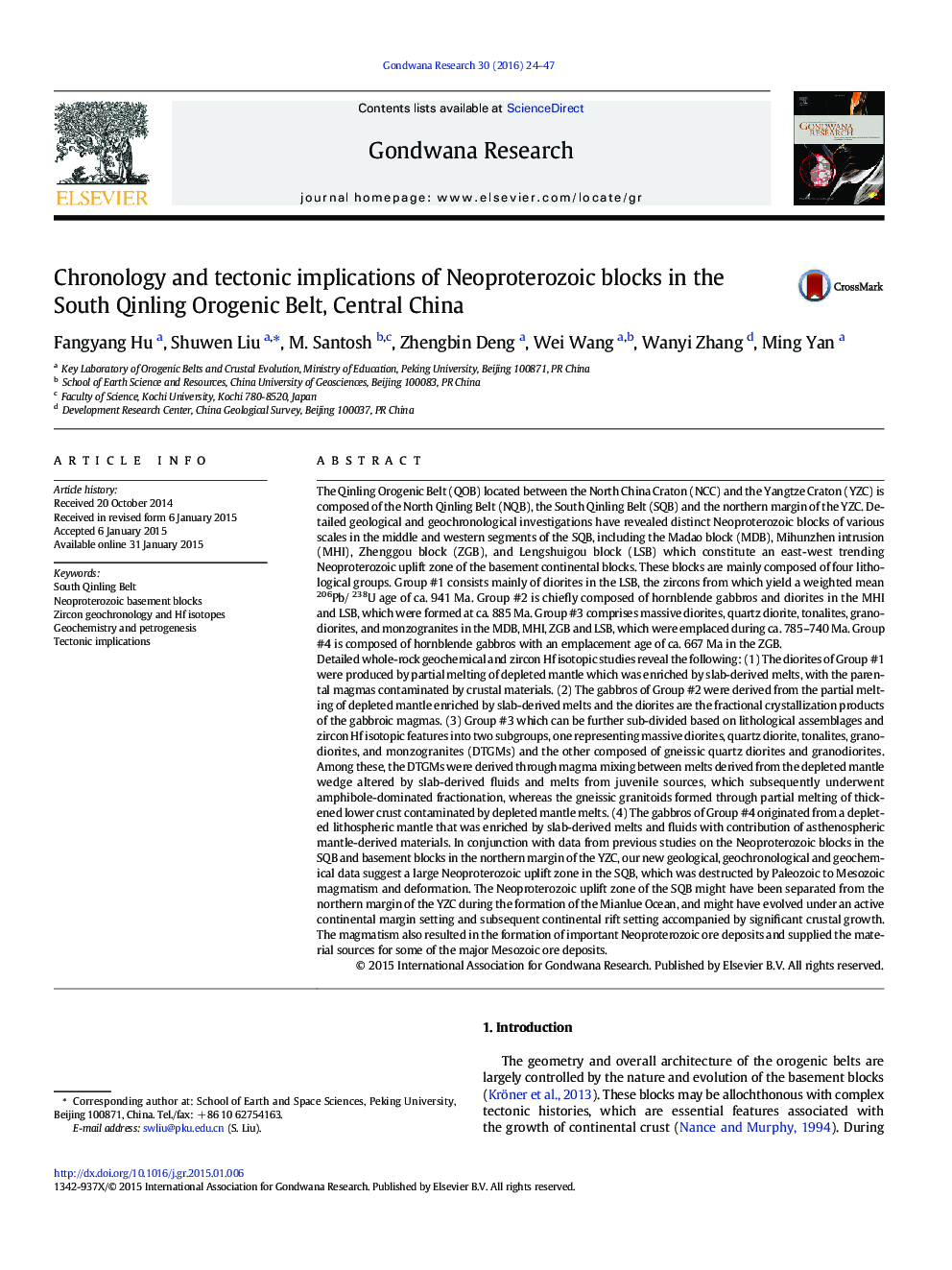| کد مقاله | کد نشریه | سال انتشار | مقاله انگلیسی | نسخه تمام متن |
|---|---|---|---|---|
| 4726653 | 1640141 | 2016 | 24 صفحه PDF | دانلود رایگان |

• A Neoproterozoic uplift zone in the South Qinling Belt, Central China
• Emplacement ages show ca. 941 Ma, 885 Ma, 785–740 Ma, and 667 Ma.
• Magmatism in an active continental margin to continental rift setting
The Qinling Orogenic Belt (QOB) located between the North China Craton (NCC) and the Yangtze Craton (YZC) is composed of the North Qinling Belt (NQB), the South Qinling Belt (SQB) and the northern margin of the YZC. Detailed geological and geochronological investigations have revealed distinct Neoproterozoic blocks of various scales in the middle and western segments of the SQB, including the Madao block (MDB), Mihunzhen intrusion (MHI), Zhenggou block (ZGB), and Lengshuigou block (LSB) which constitute an east-west trending Neoproterozoic uplift zone of the basement continental blocks. These blocks are mainly composed of four lithological groups. Group #1 consists mainly of diorites in the LSB, the zircons from which yield a weighted mean 206Pb/ 238U age of ca. 941 Ma. Group #2 is chiefly composed of hornblende gabbros and diorites in the MHI and LSB, which were formed at ca. 885 Ma. Group #3 comprises massive diorites, quartz diorite, tonalites, granodiorites, and monzogranites in the MDB, MHI, ZGB and LSB, which were emplaced during ca. 785–740 Ma. Group #4 is composed of hornblende gabbros with an emplacement age of ca. 667 Ma in the ZGB.Detailed whole-rock geochemical and zircon Hf isotopic studies reveal the following: (1) The diorites of Group #1 were produced by partial melting of depleted mantle which was enriched by slab-derived melts, with the parental magmas contaminated by crustal materials. (2) The gabbros of Group #2 were derived from the partial melting of depleted mantle enriched by slab-derived melts and the diorites are the fractional crystallization products of the gabbroic magmas. (3) Group #3 which can be further sub-divided based on lithological assemblages and zircon Hf isotopic features into two subgroups, one representing massive diorites, quartz diorite, tonalites, granodiorites, and monzogranites (DTGMs) and the other composed of gneissic quartz diorites and granodiorites. Among these, the DTGMs were derived through magma mixing between melts derived from the depleted mantle wedge altered by slab-derived fluids and melts from juvenile sources, which subsequently underwent amphibole-dominated fractionation, whereas the gneissic granitoids formed through partial melting of thickened lower crust contaminated by depleted mantle melts. (4) The gabbros of Group #4 originated from a depleted lithospheric mantle that was enriched by slab-derived melts and fluids with contribution of asthenospheric mantle-derived materials. In conjunction with data from previous studies on the Neoproterozoic blocks in the SQB and basement blocks in the northern margin of the YZC, our new geological, geochronological and geochemical data suggest a large Neoproterozoic uplift zone in the SQB, which was destructed by Paleozoic to Mesozoic magmatism and deformation. The Neoproterozoic uplift zone of the SQB might have been separated from the northern margin of the YZC during the formation of the Mianlue Ocean, and might have evolved under an active continental margin setting and subsequent continental rift setting accompanied by significant crustal growth. The magmatism also resulted in the formation of important Neoproterozoic ore deposits and supplied the material sources for some of the major Mesozoic ore deposits.
Neoproterozoic blocks in the western and middle South Qinling Belt.Figure optionsDownload as PowerPoint slide
Journal: Gondwana Research - Volume 30, February 2016, Pages 24–47